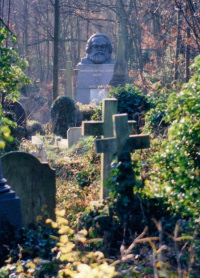Highgate
Highgate, Camden/Haringey
A much-extended village standing on high ground north-east of Hampstead Heath

Highgate took root around a village green peppered with ponds and elm trees, at the top of a 426-foot hill on the edge of the Bishop of London’s estate. It was the bishop who erected a tollgate here sometime before 1354, when Highgate’s name was first recorded. Later in the same century Dick Whittington is said to have sat upon a milestone on Highgate Hill on his way back to the family home in Gloucestershire. Inspired by the distant sound of Bow Bells, he turned again to find fame and fortune in London. A replica stone marks the alleged spot, surmounted by a 1964 statue of Whittington’s cat.
From the late 16th century a ribbon of houses began to form along Highgate Hill. The settlement was split down the middle between the parishes of St Pancras and Hornsey, as it now is between the boroughs of Camden and Haringey. The much-altered Lauderdale House was a home of Charles II’s mistress Nell Gwynne. Shown in the photograph above, taken in December 2016, the Flask public house dates from 1663.
From the late 17th century to the end of the 18th century Highgate filled with smart houses for City folk. Many of the properties survive, and so does the demographic profile.

Highgate did not gain its own parish church until 1832, when St Michael’s was built in place of a chapel of ease.
Highgate Cemetery opened in 1839 and is now divided into the western (original) cemetery and the eastern (1854), separated by Swains Lane. With its memorials, mausolea and catacombs, the cemetery is much loved by those of a gothic inclination. Nowadays you have to pay to visit.
Sir Sydney Waterlow, like Dick Whittington a Lord Mayor of London, is commemorated with a statue in the park that he donated in 1889. Waterlow Park is located north-east of Highgate Cemetery.
Shown in the photograph below, Witanhurst, on Highgate West Hill, is said to be the second largest private residence in London, after Buckingham Palace. The house’s architectural styling has been variously described as William and Mary, Queen Anne or Georgian. It was built in 1913–20 for the soap magnate Sir Arthur Crosfield and the present owner is reported to be the Russian oligarch Andrey Guryev.

Highgate’s most important 20th-century buildings are Highpoint One and Two (located at the centre of the map below), designed in the 1930s by Berthold Lubetkin for Sigmund Gestetner, the copier king. Gestetner initially intended the modernist project to provide housing for some of his Tottenham Hale workers but he changed his mind and sold them privately. Lubetkin himself took a penthouse apartment in Highpoint Two.
Highgate station opened in 1941, taking the name earlier used by what is now Archway station. This and other improvements in transport links contributed to the development of a new district to the north and east of the village that traded on the Highgate name.
To have been ‘sworn in at Highgate’ was late 18th-century slang for being sharp or clever. The term derived from a silly ceremony practised at Highgate pubs.
Postal district: N6
Population: 22,587 (Camden and Haringey’s Highgate wards, 2011 census)
Station: Northern line (zone 3)
Further reading: Robert Bard, Hampstead & Highgate Through Time, Amberley, 2015
Website: Ham & High newspaper
